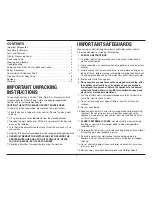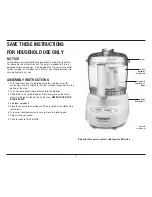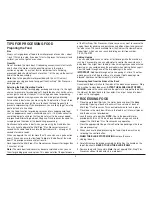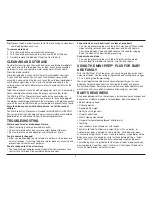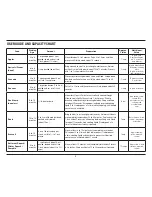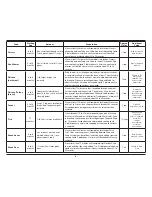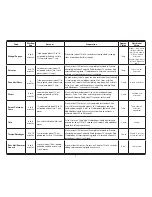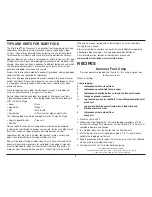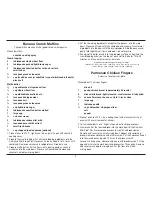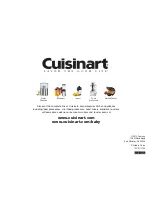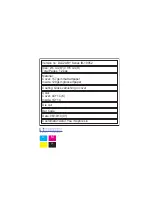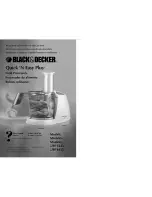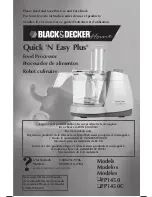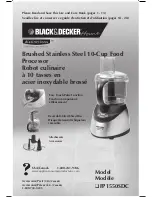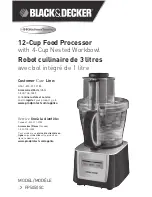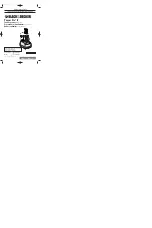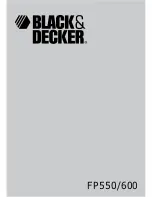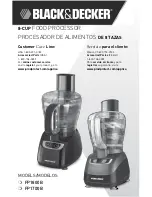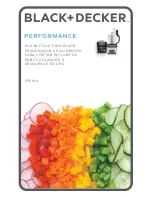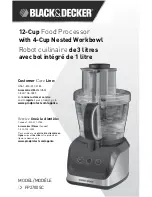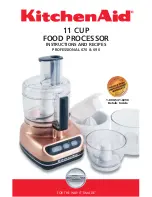
4
Tip:
Process foods in order from dry to wet to avoid having to clean bowl
and blade between each task .
To remove work bowl
1 . Turn the work bowl cover clockwise and remove .
2 . Turn the work bowl clockwise to unlock and lift off of the base .
3 . Carefully remove the blade by lifting it up from the hub .
CLEANING AND STORAGE
To simplify cleaning, rinse the work bowl, cover, and blade immediately
after each use, so that food won’t dry on them . Wash blade assembly,
work bowl, cover, and spatula in warm soapy water . Rinse and dry .
Wash the blade carefully .
Avoid leaving blade in soapy water where it may disappear from sight .
If you have a dishwasher, you can wash the workbowl, cover, blade
assembly, and spatula on the top rack . Insert the work bowl upside down
and the cover right side up . You may put the blade and spatula in the
cutlery basket . Unload the dishwasher carefully to avoid contact with the
sharp blade .
Wipe the motor base clean with a damp sponge or cloth . Dry it immediately .
Never submerge the motor base or the plug in water or other liquids .
The Mini-Prep
®
Plus Processor stores neatly on the countertop in a
minimum of space . When it is not in use, be sure to leave it unplugged .
The hidden cord storage underneath the motor base will help keep excess
cord off the countertop . Store the unit assembled to prevent loss of parts .
Store the blades as you would sharp knives – out of the reach of
children.
The Mini-Prep
®
Plus Processor is intended for HOUSEHOLD USE ONLY .
Any service other than cleaning and normal user maintenance should be
performed by an authorized Cuisinart Service Representative .
TROUBLESHOOTING
Motor doesn’t start or blade doesn’t rotate.
• Check that plug is securely inserted into outlet.
• Check that work bowl and cover are securely locked into place.
• Be sure to press only one operation control button at a time.
Food is unevenly chopped.
• Either you are chopping too much food at one time, or the pieces are
not small enough . Try cutting food into smaller pieces of even size and
processing a smaller amount per batch .
Food is chopped too fine or is watery.
• The food has been overprocessed. Use brief pulses, or process for a
shorter time . Let blade stop completely between pulses .
Food collects on work bowl cover or sides of prep bowl.
• You may be processing too much food. Turn machine off. When blade
stops rotating, remove cover, and clean bowl and lid with spatula .
Alternating between Chop and Grind reduces the need for scraping
down the sides of the bowl during processing .
Food catches on blade.
• You may be processing too much food. Carefully remove blade.
Remove food from blade with spatula, and start over again .
USING THE MINI-PREP
®
PLUS FOR BABY
AND FAMILY
With the Mini-Prep
®
Plus Processor, you can chop, grind or purée small
amounts of foods . Use the listing of ingredients and techniques on pages
5-7 as a basic guide for processing .
We’ve put together valuable information and recipes for you to use as
guidelines for your baby’s transition from liquids to solids and even to
family-friendly foods . Always keep in mind, however, baby’s doctor knows
best . Check with your pediatrician before introducing any new food .
BABY’S READINESS
Every baby develops at his or her own pace, but some common changes and
behaviors can indicate a readiness for solid foods . Be on the lookout for:
• Baby holding up head
• Chewing motion
• Doubled birth weight
• Ability to sit in high chair
• Curiosity about food
• Mouth closing around food
• Hunger after liquid feeding (breast milk/formula)
• Teething
• Less tendency to push food out with tongue
The first solid food to introduce is cereal . Start with rice, barley, or
oatmeal when baby is between 4 and 6 months . Once baby has been
successfully eating cereal, the next solid to introduce is vegetables so the
baby has a chance to develop a taste for these before getting a “sweet
tooth” from fruit . Next, introduce fruits, followed by meat and poultry .
The following chart is a guideline for the types of food to feed your baby,
how to prepare it, and how much it will serve . Other types of food not in
this chart would follow similar instructions .


